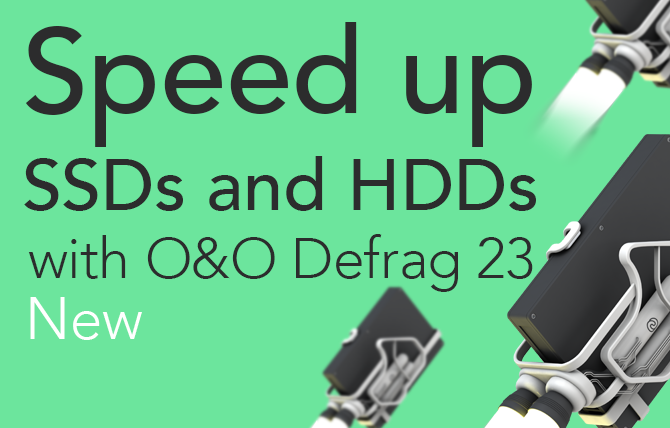With O&O Defrag 23, we present our SOLID/COMPLETE method, which enables a unique performance enhancement.
Our new O&O Defrag 23 Pro is now available with some groundbreaking new features!
SSDs have many advantages: they are fast, small and strong in memory. And they – supposedly – do not fragment. But that’s not true, because like any system that wants to save files quickly, files are distributed over the entire memory over time. So far, there were only rudimentary approaches to restore the original speed of an SSD.
The problem: every file system is fragmented. This means that over time, files will no longer be filed consecutively but, instead, be scattered across the computer’s entire storage area. This can’t be avoided because files are subject to constant changes. In order to avoid fragmentation, you’d need to know all the newly arriving files as well as all changes and deletions in advance. This is simply not possible.
The solution: This is where O&O Defrag 23 goes to work with its new SOLID/COMPLETE method: scattered file fragments will be reconnected and saved in fewer memory cells. This leads to fewer read and write accesses to these memory cells. The result is the SSD running faster and its life expectancy increased on account of reduced read and write accesses.
Along with the new SOLID/COMPLETE, the existing SOLID/QUICK method has been extended: it is now faster than COMPLETE and suitable for an occasional faster defragmentation:
- SOLID/COMPLETE: This method, developed specifically for SSDs, is a thorough optimization of the SSD.
- SOLID/QUICK: This method, developed specifically for SSDs, performs a superficial optimization of the SSD. This method is gentler and faster.
- Also new: ClusterView for SSDs: In order to represent the degree of fragmentation of an SSD, the ClusterView now maps the logical structure of an SSD so that, accordingly, 6 blocks are combined into one.
Both methods sustainably extend the life of the SSD but differ in terms of the duration and protection of the hardware.
Read our more detailed Blog entry
We have written a more detailed blog entry on this topic explaining how an SSD is constructed and the exact process that leads to fragmenting and wear and tear. You can read it right here.
The most comprehensive tuning application for all your disks
A positive side-effect of developing the defragmentation method SOLID has been found in tests on “classic” hard disks: it is O&O Defrag’s most resource and hardware-friendly defragmentation method ever, with optimal results, and sets the new standard for defragmentation.
As we mention above, files are also fragmented on SSDs. Data is often distributed to more memory cells than would be necessary. By defragmenting an SSD using our new method SOLID, it is possible to reduce the number of cells used to store file parts down to significantly fewer.
Try and Buy!
Don’t just take our word for it! Grab your copy now in our Online Shop, or alternatively test it for 30 days now on your current Windows system – free of charge and obligation. As well as the new functions, the old and trusted features for speeding up your PC and extending the lifespan of your hardware are all there too.
Here’s what some happy customers are saying about O&O Defrag:
“We have been using O&O Defrag now for many years and are very satisfied, not just with the software but also the support we receive.”
Ralf Linka, Horváth & Partners
“Only O&O Defrag Server is able to defrag these enormous, sometimes 400 GB files. All other products we tried simply couldn’t do it.”
Scott Brown, SMI.
